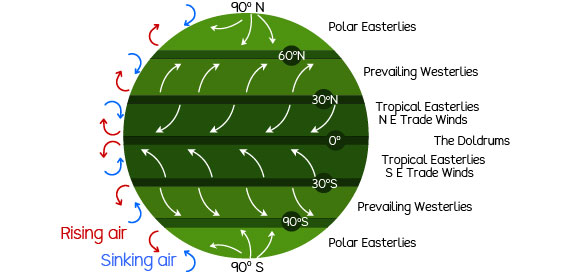- Winds
Types of winds
Local Winds
Local winds are a result of scenery such as mountains, vegetation, water bodies, and so on. They usually change very often, and the weather people talk about this kind on the TV every day. They can move from mild to extreme winds in just hours. Good examples of local winds are sea breezes land breezes, and mountain and valley breezes. Local winds cover very short distances.
Global Winds
Global winds are large air masses that are created mainly as a result of the earth’s rotation, the shape of the earth, and the sun’s heating power.

Above are some standard wind belts with the white arrows showing the direction of winds, red arrows showing vertical rising air, and blue arrows showing cold sinking air.
Doldrums:
It is the very low-pressure area along the equator where prevailing winds are the calmest. This low-pressure area is caused by the constant heating of the sun. This belt extends to about 5° north and south of the equator.
Tropical Easterlies (Trade Winds):
It is the belt extending as far as 30° north and south latitude of the Inter-tropical Convergence Zone (ITCZ).
Horse Latitudes:
It is a wind belt that forms at about 30° north and south latitude between the trade winds and the Prevailing Westerlies.
Prevailing Westerlies:
It is the belt extending from 30° to 60° latitude from the ITCZ.
Polar Easterlies:
This belt covers from 60° latitudes to the north and south poles.
